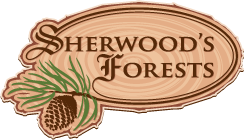
Shelterbelts & Windrows
Block the wind, keep the snow, keep the soil
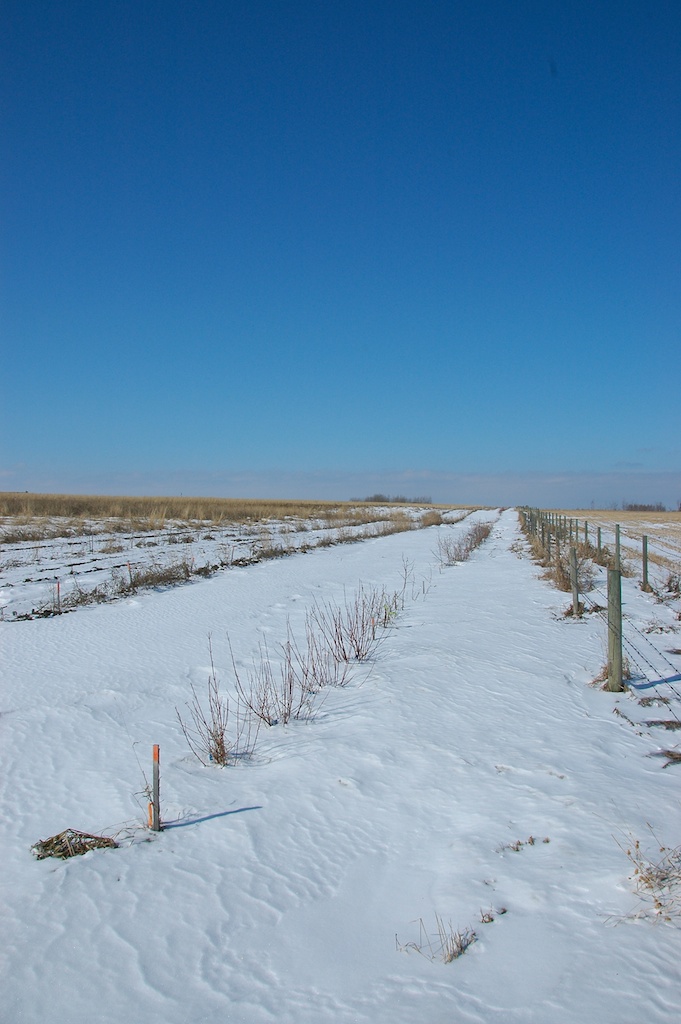
Planting a shelterbelt, or any tree project is an act of faith, and a message to the future. At this point my little dogwoods look so very small against the prairie sky. This was my first shelterbelt row.
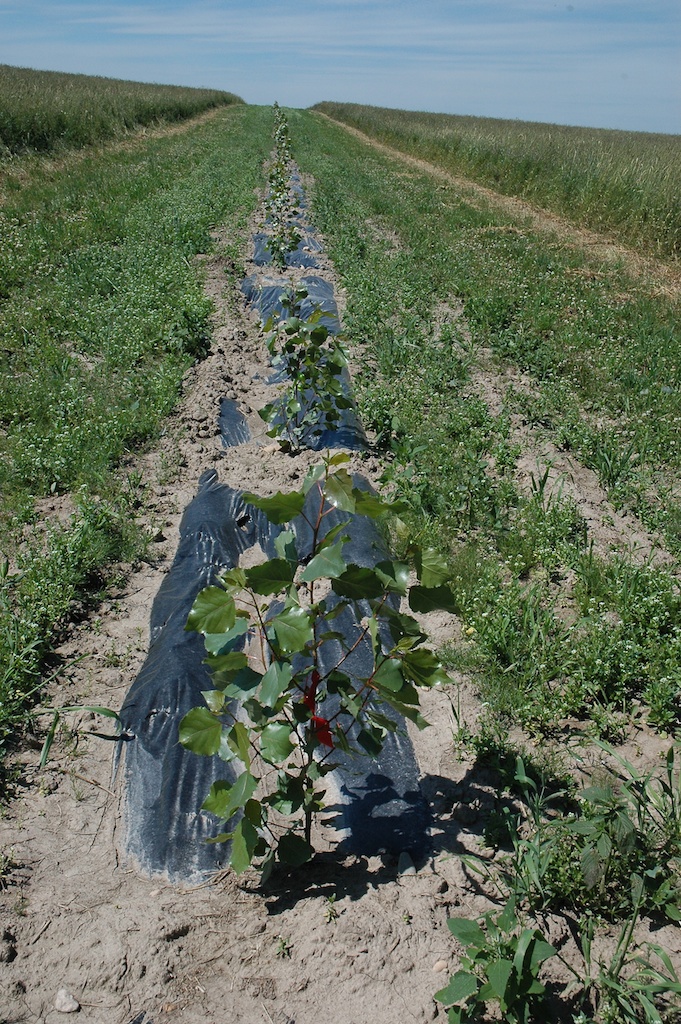
Plastic mulch is a mixed blessing. It keeps your culltivator away from the trees. But now you have to worry about tearing the plastic up. 2005
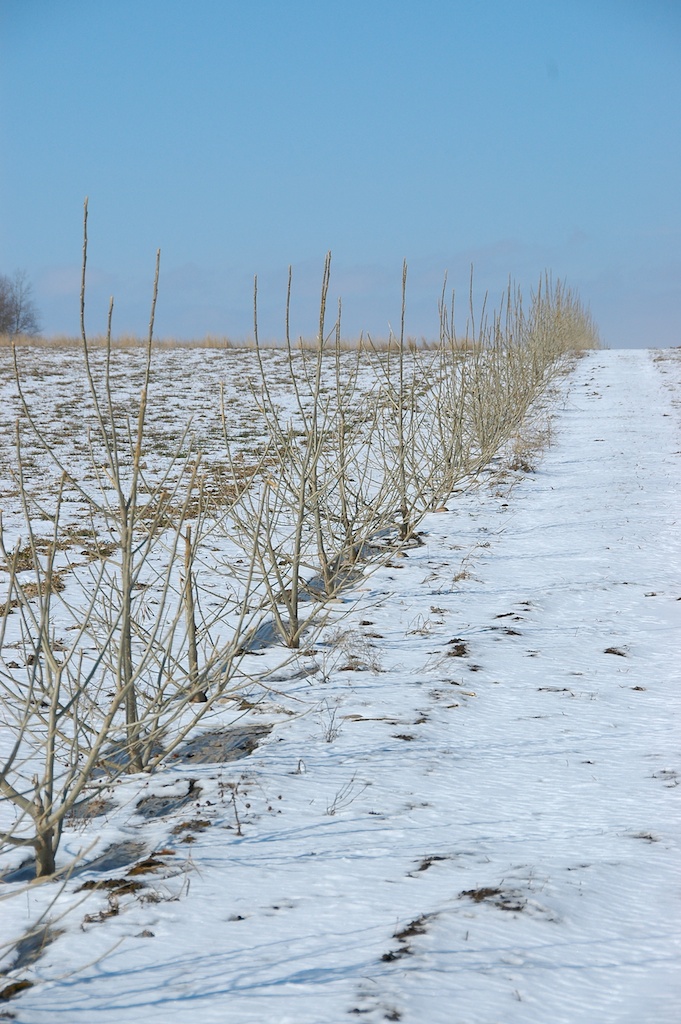
Look carefully at this shot taken in later winter 2007. Compare the height to the next one.
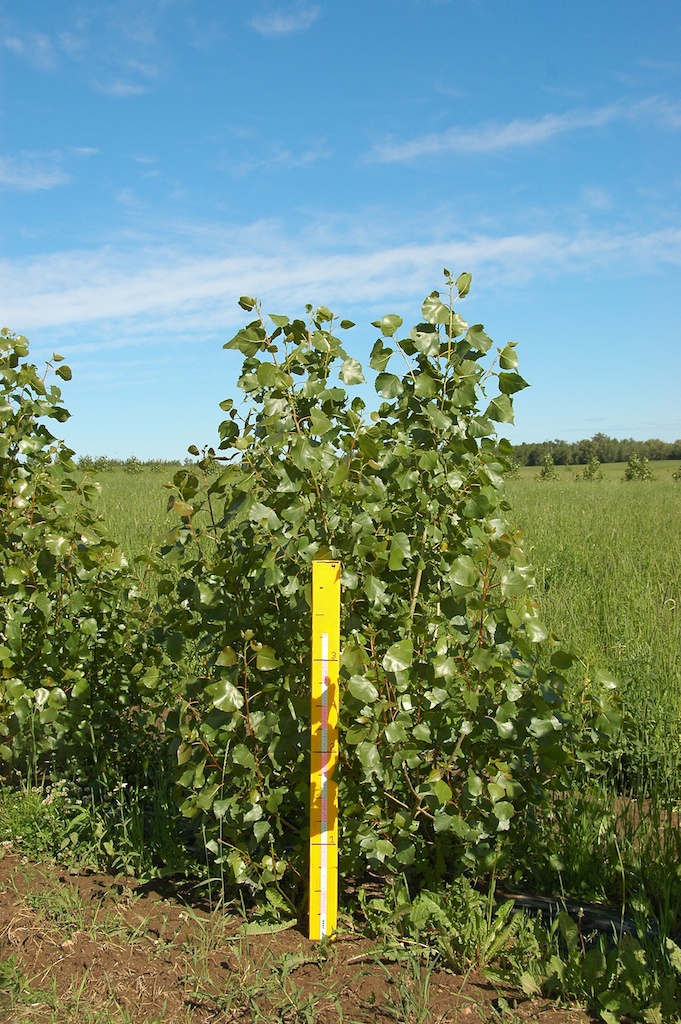
In the winter of 2007 a moose came by and ate the end two feet off of every twig. The yellow plastic is 4 feet long. We'll see it again below.
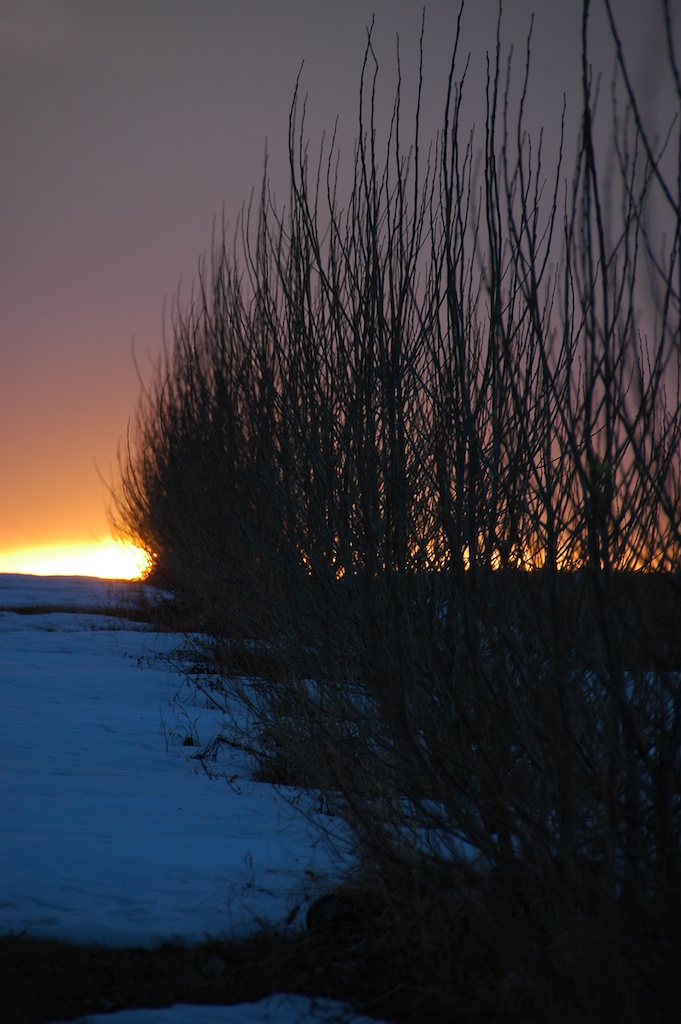
2008 The row is starting to work. It's late April. Most of the snow on the fields is gone. Still a foot deep here.
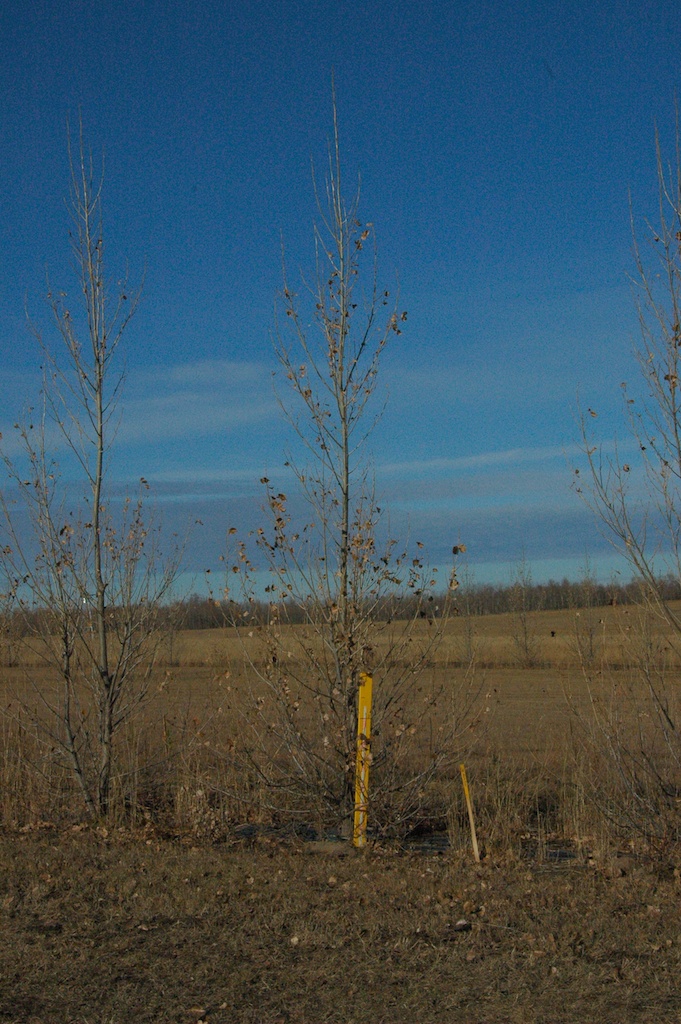 2009. Told you we'd see that yellow thing again. We're around 15 feet.
2009. Told you we'd see that yellow thing again. We're around 15 feet.
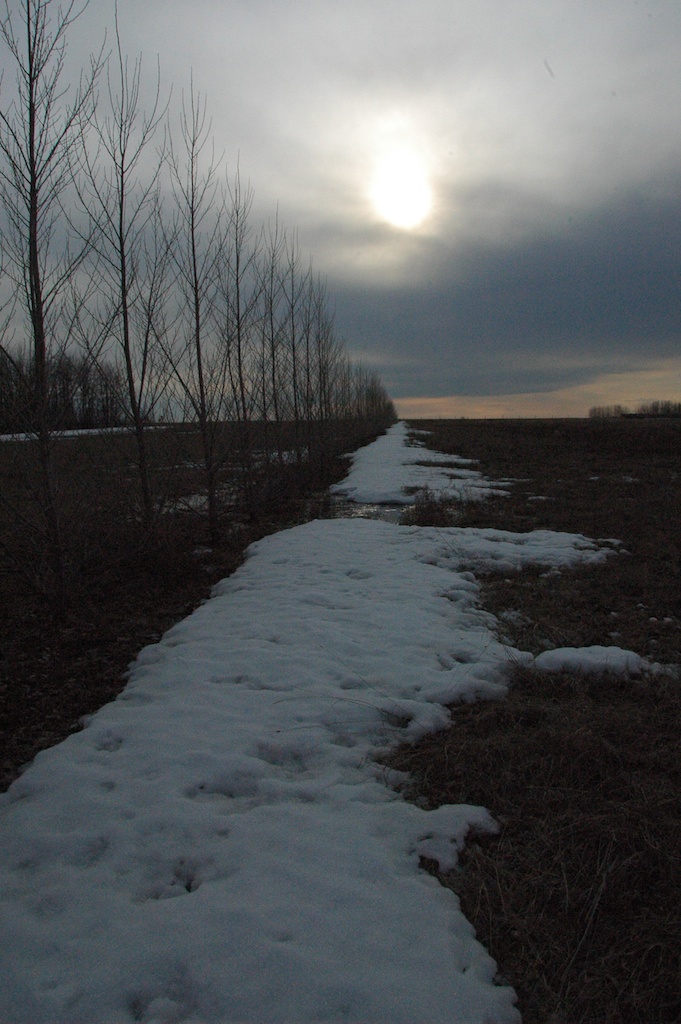
Late winter. 2011
Three sections to this file: The top is WHY plant one. The second section is HOW to plan and prepare. The bottom section is WHAT to plant.
Ten reasons for planting shelterbelts.
1. Shelterbelts create microclimates. A band of trees slows down the wind. That in turn means that heat stays around longer which in effect lengthens your growing season. A wall of spruce really makes a difference: A 20 foot wide strip on the south side of the spruce grove in my yard melts free of snow a good two to three weeks before the rest of the yard.
2. Shelterbelts stop the snow. Nothing like having the driveway drift in for the third time in two weeks. The county road I'm on has a half mile stretch with not much in the way of trees on either side. A day of wind, and there can be 18" drifts on that stretch. From my house to the highway is well treed. No drifts.
3. Lower your heat bill. If you have an older house (pre R-2000 construction style) good shelterbelts can put a large dent in your heating bill. This goes double for out buildings with their generally less tight construction and lower levels of insulation.
4. Save water. In fields, shelterbelts coupled with field belts (1 row of trees) can slow down the wind enough to make a serious dent in wind loss evaporation. (The wind will carry off snow moisture. The sun's action on a still day results in fine snow growing into larger crystals, less subject to direct evaporation. Liquid water moves downward through the snowpack.)
5. Lower feed costs. Livestock take less feed for maintenance if they can get out of the wind
These deal with my own experience having trees by my tree nursery.
6. Deer Control. I have a row of poplar every 200 feet across my tree farm, and it has made a huge difference. In my main pot yard the snow now drifts to about twice the depth in the open fields. This is sufficient that I don't have a winter deer problem. They go to the deep bush where there is less wading through deep snow per twig.
7. Reduce irrigation wind drift. I put in another row of brooks poplar running parallel to a block that is irrigated with overhead sprinklers. Before I could only water this block at night becuase of wind drift. Now, about half the time I can water at least in the morning.
8. Habitat for benefical birds. The rows have a strip of unmowed grass next to them. Between the grass and the trees there are a raft of nests for LBJ birds. (Little brown jobbies.) I essentially have zero pest issues. Oh occasional the aphids will surge and I will have to give a hard water spray on the choke cherries to knock down the population so the chickadees can catch up, and I have gotten the occasional flurry of adelgids in my spruce, but I've spent nothing, nada, zero, zip, zilch on insecticides for the last 15 years.
9. Spring operations timing. The deeper snow postpones spring by about a week. My schedule accomodates this. I have reserves of potting soil tarped, and I can start repotting before the trees break dormancy. This is a significant win.
10. Better conditions for overwintering. I can overwinter pots for many species above ground. None of this tip and tarp. Pot in pot is used for some of the more sensitive trees, and for trees that are large enough to be blown around.
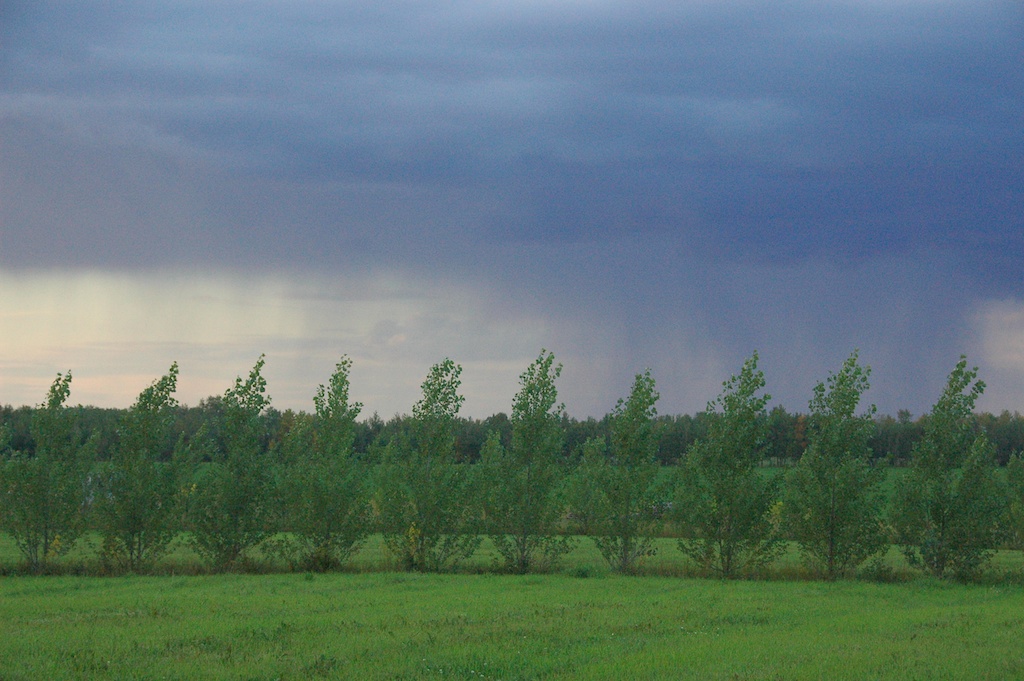
Shelterbelt against one of the tiny thunderstorms that like to run around in early fall. This is 2010, They were planted in 2003.
So you want to plant a shelterbelt...
Mix it up. Instead of a mono-culture, use at least two different species. I recommend using either poplar or pine, alternating with spruce.
First advantage: Both poplar and pine tend to drop their lower branches as they mature. spruce tend to stay wide at the bottom.
Second advatage: Different species have different rooting habits. By alternating them you aren't putting them in as much water stress during a dry year.
Third advantage. Few pests attack trees of different families. A tent caterpillar on a poplar has a harder time reaching the next poplar if there is a spruce between. Worst case if all of the leaves are eaten off the poplar, you still have the spruce.
Fourth advantage. Poplar grow fast. You get some results starting in about 5 years. The spruce are slower but they will outlive the poplar by 50 years. Pine aren't as fast as poplar, but they still grow a lot faster than spruce.
Make more than 1 row. A double row creates a whole new world in that narrow strip between the two rows of trees. Traditionally we were hopelessly organized and put in a row of poplar and a row of spruce. Mix each row. Plant them in a checkboard pattern. If you plant on a 10 foot grid, two adjacent spruce are 14 feet apart -- the diagonal of the square instead of the side.
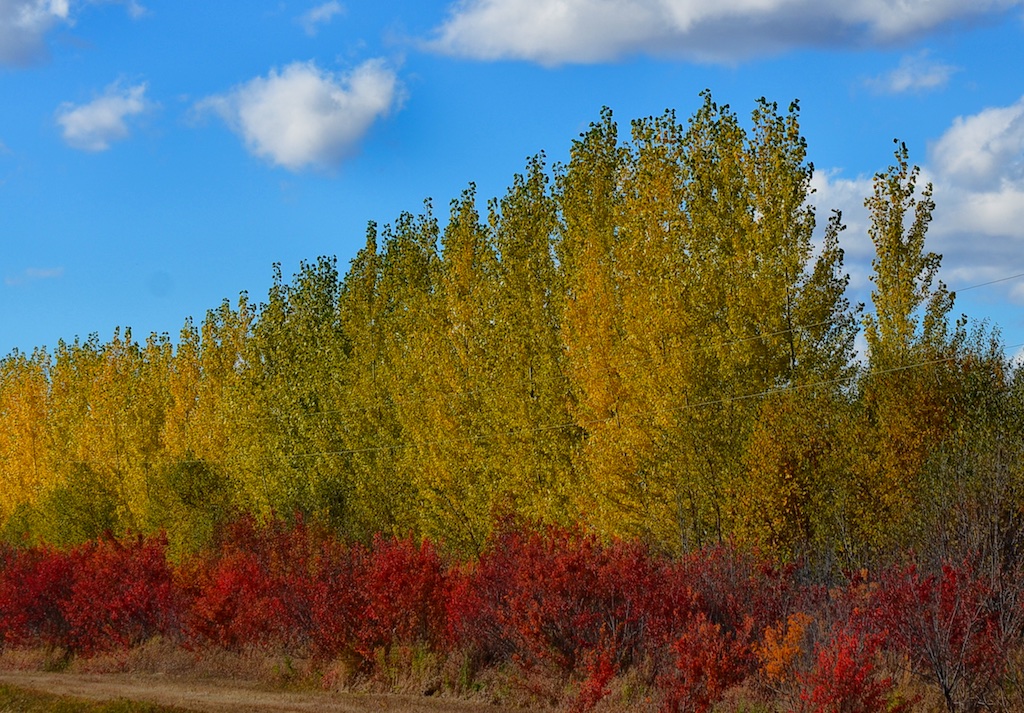
Poplar tend to drop lower branches later in life. Here, a row of native chokecherry adds to the effectiveness.
Considerations on Shelterbelts
Shelterbelts aren't all roses. They are a lot of work to get established, and can be a source of weeds.
Plan a full year ahead.
- Exhaust the current weeed seed bank. Best way to do this is to till, wait for a flush of weeds, till, then plant a fast germinating crop such as buckwheat. Mow and till in when it finishes blooming, but before the seed has set. Plant again with buckwheat. Or an annual legume. Again mow and till after bloom. The idea here is that you want something that will crowd out any perennial weeds in that band. Failing this, till it everytime the weeds and grass gets 3 inches tall.
- Establish a short grass. Sheep's fecue is ideal. You can get this started in fall. Seed more heavily than you would for pasture, and run a packing roller.
OR
- Keep it bare, plant into tilled earth and use plastic mulch for weed control.
- Next spring plant your trees. I recommend 10 foot spacing. PFRA was recommending 8 feet for years, but 10 gives you some extra insurence in dry years, and makes it a lot easier to run a mower between the trees.
- Until the trees are 8-10 feet tall, you need to reduce the weed competition as much as possible. Keeping it mowed short works reasonably well. Spraying also works. Poplar can absorb spray thorugh their trunk until it's rough. Spruce are insensitive to glyphosate when they are dormant. I've found that mowing needs to be done more often -- typically 3-4 times a season, but that overall it's faster than spraying.
- If you can, water three times during the first few years. Water deeply rather than often. If you plan on doing this, set up basins around the trees. Basins should be about 2 feet across by an average of 4 inches deep. This will funnel rain water, and irrigation water to the trunk. You will be able to drop 5 gallons of water in the basin, and have most of it soak in by the tree.
- An easy way to make basins is to rig a two foot wide strip of something on any 3 point hitch implement. The archetype example is a two foot wide x 1 foot scrap of 1/4" steel bolted to the back of a blade. Mark your spots with spray paint, or scratch a line with a hoe. Drive over the row, and drop the implement enough to make the basin. If there is a slope, do this going down hill. You want the higher edge on the downhill side.
- If you are borrowing a tree planter to do this, plant the trees a few inches too deep, then come back and clear out the extra dirt. This is easiest if done in two stages: First get most of the dirt out with a vineyard hoe. (Dutch hoe with a 6" x 6" heavy iron blade) Then make a second pass by hand to uncover the root collar. Willows and poplar are not critical about being planted too deep. Most conifers will rot off if the root collar is more than 2 cm under the surface.
- Reseed the disturbed area with sheeps fescue or whatever short grass you used before.
- Once established, you may need to mow now and then to control weeds. If you use a garden mower, rig something to lift the drooping branch tips of the spruce so you can put the edge of the mower deck under the tips.
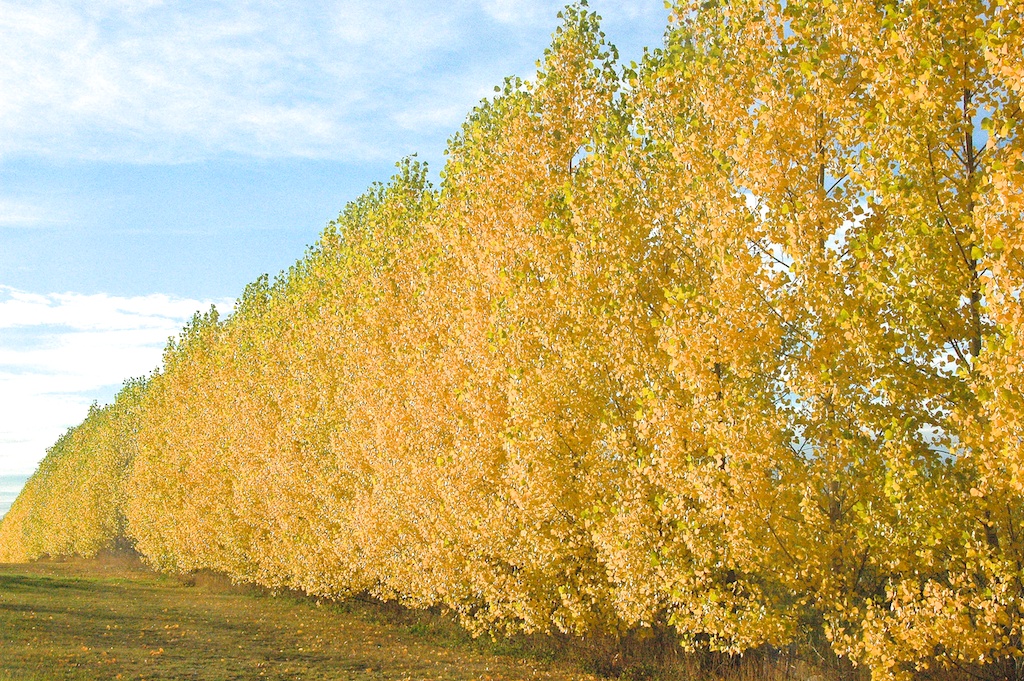
One of the things I love about Hill Poplar is the way it holds on to leaves late in the fall. Many of these are now 30 feet all. 2013.
More Tips
- If this is your first time, then before you plant trees, plant sticks. Now do all the operations you will do while you are getting them started. Mow. Till. Whatever. I did my first shelterbelt with trees 8 feet apart. My little rototiller on the back of the garden tractor couldn't do left turns in that space. Needed a 9 foot space. If I had found that out with sticks, I could just move the sticks.
- Spacing: If you have a 7 foot cultivator, make the rows 10 feet apart. You are likely doing this with a utility tractor. It's hard to watch clearance on the bucket in front and the cultivator in back at the same time. Having a couple feet of 'knee jerk' room will help. 'Tractor Blight' is a leading cause of mortality in young trees. Also: Be a bit generous with room at the end of the row, or be ready to sacrifice the end tree.
- Plant a stick with every tree. A green leafed trees is really hard to find in the weeds if the weeds ever get ahead of you. (All it takes is 3 weeks of too wet fields...) Put in a survey stick, one with the end painted bright orange. Put it on the same side of the tree every time.
- If you use chemical control methods use shielded sprayers. One trick to protect a tree when working with a back pack sprayer, or a wand off the tractor sprayer.
- Cut the bottom off a pail, then cut the pail in half, giving you two half cylinders without ends.
- Attach a half pail to a 4 foot long stick. Now you have a guard that you can use without bending over while you spray.
- Cultivate shallowly after the first summer. Most poplars have roots close to the surface. You don't want to go very deep. I suggest a rototiller set to just skim the surface, or a short tooth harrow. Do a bit of trowel work ahead of time and find out how deep the roots are. While bare ground is better in terms of plant growth, that's only true if you don't cut off the roots. This is why I normally recommend mowing.
- For some trees, applying Casoron 4g in the fall can make for effective weed control near the tree. Note that spruce and some other trees will be killed by this. Read the directions.
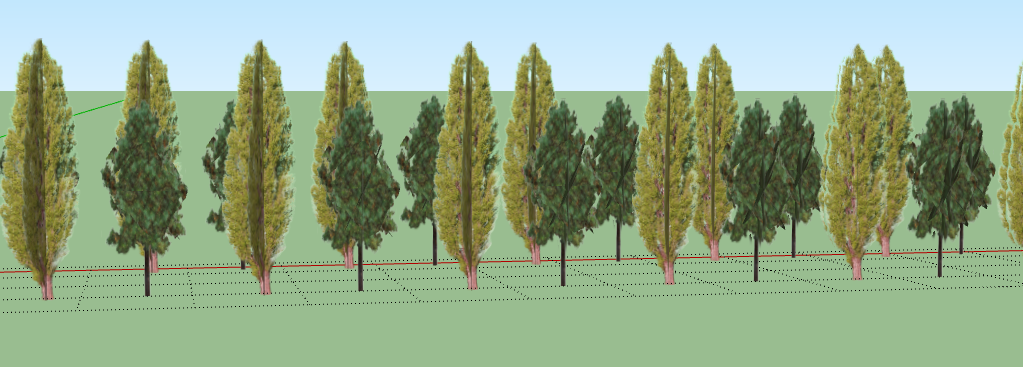
If you plant a checkerboard, the trees can be spaced closer together. In this case a mix of poplar and spruce. By the time the spruce get big, the poplar are dying of old age. The checkerboard pattern puts them further apart, so they won't touch.
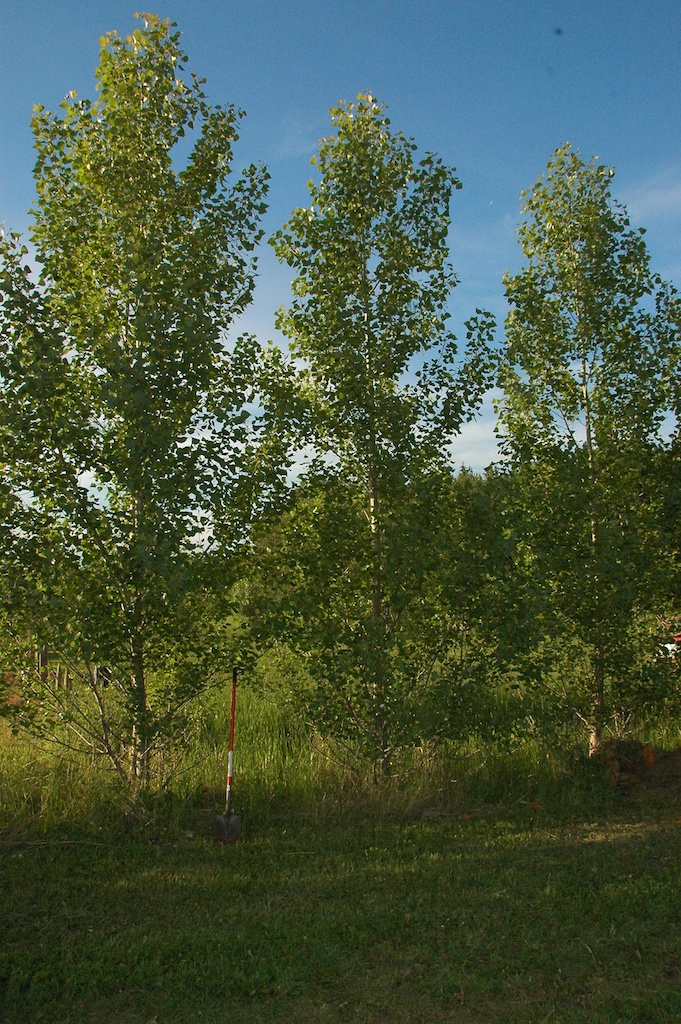
The thin red thing? That's a shovel. 2012.
What to plant
Hybrid poplars
Hybrid poplar grow fast. At present I'm recommending Northwest, Brooks, Okanese and Hill. All but Hill are male clones.
Northwest: Taller than the others at maturity with a spreading crown. Good shade provider for yard or lifestock. May have more value for timbers with it's larger diameter.
Hill: Best if you are doubtful about weed control Seems to compete better than others. It doesn't produce a lot of fluff, and most of the seed is sterile.
Okanese: is a new one, Supposed to be more disease resistant, less winter damage.
Brooks No. 6: is a standby similar structurally to Okanese, but with bigger leaves.
Native poplars
I also have balsam poplar and some years trembling aspen.
Willow
There are tree willows and shrub willows. The tree forms are not as tall as poplars. Because willow need full sun, on an east west multirow shelterbelt they should be south of the poplars.
Tree willows: Laurel Leaf Willow, White Willow Golden Willow. Laurel is wider and denser. White is by far the tallest. I don't know yet (2014) how dense the shade gets, as I've just started growing it. Golden lets more light through, and because it's a multistem giant shrub does a better job with snow drift.
Shrub willows: Pussy willow, Common osier willow, flame willow. Common osier makes the densest hedge. Flame has better height. Pussy willow better for wet spots.
Pine
I recommend two pines for shelterbelts, Lodgepole and Scots. Lodgepole is better for sandy areas, scots for clay areas. Pines do NOT like wet feet. Do not plant in depressions, swales, places that are often later drying out in spring.
Spruce
All spruce are shade tolerant. Most of them prefer partial shade when small. Two spruces are in common use for shelterbelts. Our native white spruce, and colorado spruce. If you have wet areas, another one to consider is black spruce.
- Colorado is the most drought tolerant, and the most dense, but also the slowest growing.
- White spruce is the fastest growing of the bunch, and will tolerate cold water flooding in spring, but cannot tolerate saturated soil for more than about a week in the growing season.
- Black spruce is more tolerant of flooding, and in reasonable soil instead of a bog looks almost identical to white spruce. It doesn't get as tall.
- Some years I can get black hills spruce. This is a variety of white spruce that is somewhat denser. It also doesn't go as yellow green in winter,
Other shrubs
I also carry dogwood, chokecherry, pin cherry, green alder, canada buffaloberry, wolf willow, snowberry, high bush cranberry.
Formats and Sizes
Not all trees come in all forms. I can usually grow or get any format or size with a year's notice. These are in approximate order of increasing cost.
Cuttings: Willows, except beaked willow, and poplars except trembling aspen. Order by end of March before planting.
Plugs: Everything. This is a standard 410 to 412a plug. Root volume of about 100 cubic centimeters. Order deadline January. October is better.
Big plugs: Some of the shrubs I do here. These are 250 to 335 ml plugs. Think Campbells Soup can. Small quantities available on demand, but subject to prior sale. Chokecherry, dogwood, wild rose, sea buckthorn, caragana, possibly others.
Bare root: Deciduous trees 12-18" Conifers are 3-4 years old. Common and late lilac, manitoba maple, silver maple, buckeye, black ash, green ash, siberian crabapple, ursurian pear, bur oak, amur maple, saskatoon, caragana, dogwood, russian olive, sea buckthorn, nanking cherry, golden current, red elder, silver buffaloberry, snowberry, colorado spruce,scots pine, ponderosa pine and siberian larch.
Super plugs: These are one liter plugs -- 4" x 6". Shrubs are usually 2 feet tall in this size, and compete well against weeds. These take 1 year for willow and poplar, 2 years for everything else. Basically anything I can get in a plug, I can grow for another year in a super plug. Willow and poplar are planted directly as cuttings.
No. 1 Trade pot: Anything in a plug or cutting. #1 pots aren't big enough for most bare root.
No. 2 Trade pot: Anything in a plug, cutting or super plug, with 1-2 more years. A few of the smaller bare root trees can be planted for a year in these. Recommended format for planting with a shovel.
No. 2 Stuewe pot: Most bare root stocks. This is my preferred size for larger willows and poplars. The pot is 16" tall x 6" square, so that it lends itself to planting with a 10" auger. The deeper roots give increased drought resistance. Trees are 3-4 feet tall. This gives good competition with weeds.
More info about shelterbelts:
Field Shelterbelts for Soil Conservation
More info on Alberta Government Ag site
Got something to say? Email me: sfinfo@sherwoods-forests.com
Interesting? Share this page.
Want to talk right now? Call me: (8 am to 8 pm only, please) 1-780-848-2548
Do not arrive unannounced. Phone for an appointment. Why? See Contact & Hours That same page gives our hours of operation.
Back to Top
Copyright © 2008 - 2021 S. G. Botsford
Sherwood's Forests is located about 75 km southwest of Edmonton, Alberta. Please refer to the map on our Contact page for directions.
